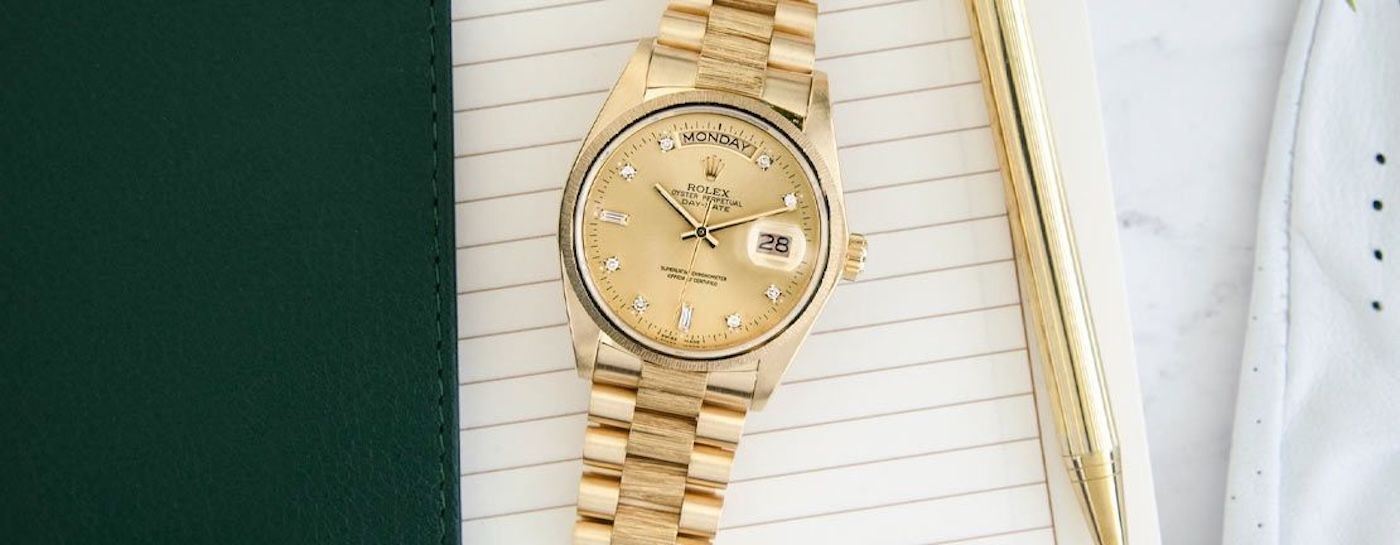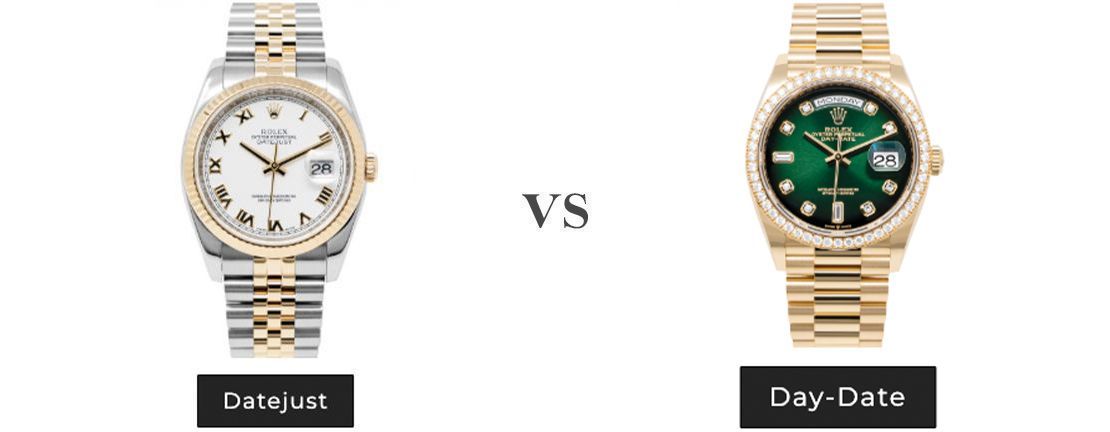It would be tough to find two more iconic watches in the Rolex collection than the Datejust and Day-Date. These well-known timepieces echo the famous luxury watch brand's watchmaking excellence and are both well-established in the Rolex lineup, with over seven decades of heritage in each piece.
When it comes to Day-Date vs. Datejust, both appeal to different tastes, lifestyles, and (more significantly) budgets. Through this article, we shall break down the key differences and provide a clearer picture of these two magnificently seminal timepieces.
If you are currently deciding between a Rolex Datejust vs. Day-Date, our comprehensive guide will help you fully grasp each model so you can choose the one that best suits your own style and personality.
Rolex Day-Date vs. Datejust Key Features:
Datejust
- First Released: 1945
- Available Case Sizes: 26mm, 28mm, 31mm, 36mm, 41mm
- Case Materials: Stainless steel, white gold, yellow gold
- Bezel Options: Fixed or rotating; domed, fluted, or diamond-set
- Dial Layout: Date window positioned at 3 o’clock
- Crystal Options: Acrylic (vintage) or sapphire; includes Cyclops
- Bracelet Choices: Jubilee, Oyster, President, and leather strap
- Movement Calibers: 1135, 1166, 2035, 2135, 2235, 2236 (ladies and midsize models); 1035, 1065, 1565, 1575, 3035, 5035 (quartz); 3135, 3136, 3235
Day-Date
- First Released: 1956
- Available Case Sizes: 36mm, 39mm (Masterpiece only), 40mm, 41mm (Day-Date II)
- Case Materials: Gold, Platinum
- Bezel Options: Fixed; available in domed, fluted, diamond-set
- Dial Layout: Day displayed at 12 o’clock, date at 3 o’clock
- Crystal Options: Acrylic (for vintage models) or sapphire with Cyclops
- Bracelet Choices: President, Oyster, Leather, Pearlmaster (Masterpiece)
- Movement Calibers: 1055, 1555, 1556, 3055, 5055 (quartz), 3155, 3156, 3255
Rolex Day-Date vs. Datejust History
Both pieces were designed and created shortly after World War II and have rich histories. Given the breathtaking complications of many luxury Swiss watches in this modern age, you would be forgiven for viewing either one as ‘remarkable but quite standard’ for Haute Horlogerie movements.
However, ‘revolutionary’ might be an apt description of the Rolex Datejust and Day-Date. Both watches boasted remarkably complicated movements for their respective eras, drawing immense admiration from watch collectors everywhere.
Datejust History
Introduced in 1945, the Rolex Datejust was the company’s first self-winding chronometer wristwatch with a date display, released to celebrate its 40th anniversary. It was also the first automatic, self-winding wristwatch to feature a date function, which changed automatically at midnight.


Originally available only in solid gold, the range later expanded to include stainless steel and Rolex’s signature steel-and-gold combination, Rolesor.
This evolution gradually bridged the gap between classic dress watches and sporting or utility timepieces.
The Datejust would not look out of place adorned in a high-level c-suite meeting or a day at the beach, having earned a reputation for being an anytime, anyplace Rolex. This wide appeal has led to the Datejust becoming one of Rolex's most popular models.
Day-Date History
The same everyman approach could not be said of the Day-Date, which has an entirely different persona. More commonly known as the President’s Watch, the Day-Date was launched in 1956. It earned its nickname due to its popularity among world leaders, including U.S. President Lyndon B. Johnson, no less.


The Day-Date was the first watch to display both the day of the week spelled out in full and the date. Again, it is difficult to convey just how utterly groundbreaking this was for its time, but to create such a complicated movement was considered nothing short of seminal.
The Day-Date is (and always has been) made only from solid precious metals such as gold and pure platinum. Unlike the Datejust, it has remained unwavering in that regard, with no steel anywhere in sight.
This is most certainly not a watch you would ‘wear on the beach' and is considered one of the more desirable watches in the Rolex collection, with a highly distinctive style. In comparison to the Datejust, It is generally viewed as more exclusive, largely fueled by a price tag that is five times more expensive than its counterpart.
Day-Date vs. Datejust | Design and Display Differences
At a passing glance (and to the unfamiliar eye), the differences are not overly apparent when it comes to the Rolex Day-Date vs. Datejust. On closer inspection, however, the differences are actually quite striking.
| Feature | Rolex Datejust | Rolex Day-Date |
|---|---|---|
| Launch Year | 1945 | 1956 |
| Main Display | Date at 3 o’clock, Cyclops | Day at 12 o’clock, Date at 3 o’clock |
| Sizes Available | 28mm, 31mm, 36mm, 41mm | 36mm, 40mm |
| Material Options | Stainless Steel, Rolesor, Gold | Yellow Gold, White Gold, Everose, Platinum |
| Bracelet | Jubilee, Oyster | President, Oyster |
| Reputation | Everyday wear, versatile | Luxury, formal occasions |
| Key Feature | Simplicity and flexibility | Use of precious metals, full-day display |
| Waterproof | 100 Feet | 100 Feet |
Rolex Datejust Design
The Rolex Datejust is appreciated for its clean, simple look with a focus on practicality. Its most telling feature is the date display at 3 o’clock, which is enhanced by the Cyclops lens for easy legibility. With size options ranging from 28mm and 31mm to 36mm and 41mm, the Datejust will lend itself to a wide range of wrist sizes.
It is also available in a range of materials, from stainless steel to Rolesor (a steel and gold combination) through full gold models, and is therefore suitable for both casual wearers and anyone seeking a touch of extra luxury.


Rolex Day-Date Design
The Rolex Day-Date famously offers an added complication in the form of a day display, fully spelled out at the 12 o’clock position, in addition to the date window. The Datejust is available exclusively in precious metals, including yellow gold, white gold, Everose gold, and platinum.
Unlike the Datejust, the Day-Date offers fewer size options, with only 36mm and 40mm models available. Its design is generally considered a bit more formal in nature.
Both models feature the iconic Rolex fluted bezel.
Dial Options for Rolex Datejust vs. Rolex Day-Date
Datejust Dials
- Classic Dial: Found on the Datejust, this option includes Roman numerals or baton hour markers in colors like silver, black, and white.
- Mother of Pearl Dial: A refined, iridescent dial available in some Datejust models, often combined with diamond hour markers for added elegance.
- Floral Motif Dial: A unique option for some Datejust models, featuring a delicate flower pattern that adds a playful touch.
- Sunburst Dial: Popular on Datejust models, the sunburst effect reflects light beautifully, adding a sense of depth to the face.
Day-Date Dials
- Lacquered Dial: Often seen on Day-Date models, this glossy finish offers a high-contrast background for the day and date displays.
- Mother of Pearl Dial: A luxurious option available on some Day-Date models, often paired with diamond hour markers.
- Diamond-Set Dial: Found exclusively on higher-end Day-Date models, this dial option includes diamonds as hour markers.
- Stone Dials: Available on the Day-Date, featuring materials like malachite, onyx, or lapis lazuli.
Rolex Datejust vs. Day-Date Movement and Spec
In terms of movements, Rolex has provided both Datejust and Day-Date models with some of the most advanced mechanical technology in watchmaking, just as one would expect.
The Datejust 36 and 41 are driven by the Caliber 3235, while the smaller Datejust 31 features the smaller Caliber 2236. Despite their differences, both calibers offer an impressive 70-hour power reserve.
What makes these movements truly remarkable are the intricate developments that Rolex enthusiasts value. The Caliber 3255, powering the Day-Date, includes Rolex’s patented Chronergy escapement, designed for greater accuracy and resistance to magnetic fields.
A key component across these models is the paramagnetic blue Parachrom hairspring, which also provides increased resistance to magnetic fields while aiding stability in changing temperatures.
For added durability, Rolex equips these models with Paraflex shock absorbers, a system designed to protect delicate movement from impacts. This feature ensures both the Datejust and Day-Date can withstand the wear and tear of daily use while maintaining the precision they are reputed for.
Practical features, such as the quickset and double quickset mechanisms, allow easy adjustment of the date and, in the Day-Date’s case, the day.
Rolex Datejust vs. Day-Date | Evolution of Movements
Historical movement advancements also contribute to their appeal, at least from an enthusiast's point of view. The Day-Date's early models used the Caliber 3055, boasting only a quickset function. This allowed for easy date adjustment but required manual winding for the day function.
In 1988, the Caliber 3155 introduced the double quickset feature, which made adjustments much simpler by allowing the day and date to be changed independently.
In turn, the Datejust saw similar improvements. Before the mid-seventies, manual winding was required for date changes, but the introduction of the Caliber 3035 in 1977 offered a quickset function, making it far more convenient for users.
Datejust vs. Day-Date Bracelet Options


The Rolex Datejust comes with two classic bracelet options: the Jubilee, known for its elegant design, and the Oyster, which offers a sportier aesthetic. Both options ensure the usual comfort associated with a Rolex bracelet - only personal taste will dictate which of the two is favored by the buyer. Conversely, the Rolex Day-Date features the Oyster as well as the exclusive President bracelet with semi-circular links.
Buying Rolex Datejust vs. Rolex Day-Date | Typical Pricing
As you might expect, the different materials used play a huge role in the pricing of new and used Rolex Datejust and Day-Date watches. With the Day Date crafting each piece in either full gold or platinum, the price discrepancies between the two models are vast.
That's not to suggest one is ‘better’ than the other - they simply take a different approach in terms of precious metals. Either way, the pricing reflects that.
New and Used Prices
For a Datejust, prices from an authorized dealer start at around $7,500 for stainless steel models and can go upwards of $15,000 for versions featuring gold. Prices can reach five figures for certain Datejust models with diamonds or other precious gemstones.
By the same token, a new Rolex Day-Date (bearing in mind the exclusive use of precious metals like 18k gold or platinum) typically starts around $35,000 and can exceed $100,000 at the higher end, depending on the model and customizations.
On the pre-owned market, the Datejust remains far more accessible, with pre-owned Datejust prices starting at approximately $5,000 for entry models in reasonable condition.
Pre-owned Rolex Day-Date watches hold their value extremely well, with entry prices currently around $20,000, rising to $80,000 for special gem-set models.
Rolex Datejust vs. Day-Date | Popular References
Rolex Datejust
- Datejust 1601: Vintage model with a fluted bezel and Jubilee bracelet.
- Datejust 126234: Modern stainless steel model with a white gold bezel.
- Datejust 16233: Rolesor (steel and gold) model with a champagne dial.
- Datejust 116233: Two-tone model combining stainless steel and yellow gold.
- Datejust 126300: Contemporary option in full stainless steel with a smooth bezel.
Rolex Day-Date
- Day-Date 1803: Classic model in 18k gold.
- Day-Date 18238: Vintage yellow gold model with the double quickset feature.
- Day-Date 118238: Yellow gold model featuring the Caliber 3155 movement.
- Day-Date 228238: Modern yellow gold model in 40mm with the Caliber 3255.
- Day-Date 228206: Platinum model with an ice-blue dial.
Day-Date vs. Datejust | Summary
Despite both pieces' similar-sounding model names and extremely close history, the Day-Date and Datejust tend to serve different markets.
The Day-Date is more exclusive (and arguably more desirable), as it is only available in gold or platinum. It is probably not a piece you would want to wear while out running errands or a spot of fishing. It would be far more at home in gala events or executive meetings.
Click here to view our range of Pre Owned Rolex Day-Date watches
The Datejust feels comfortable in any situation, at any time, on any wrist. It is a watch you can adorn with pride in the aforementioned gala event or just running chores in the local area.
Click here to view our range of Pre Owned Rolex Datejust watches
The choice, as always, is nuanced and subjective. Either way, both are magnificent watches.


